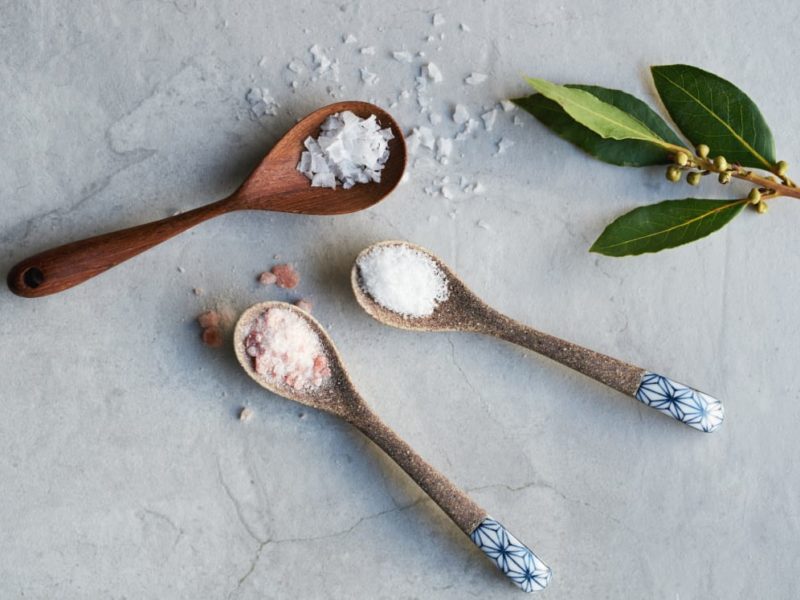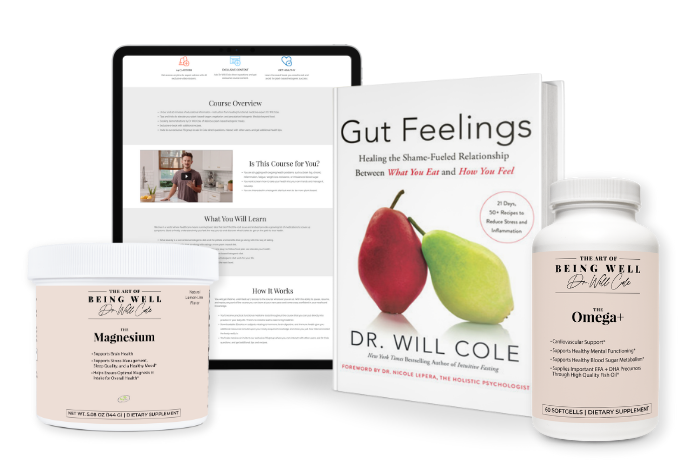A Functional Medicine Guide To The Healing Powers Of Sea Salt

Do you consider yourself well-traveled? Maybe you should take up scuba diving. A full 95 percent of our oceans remain unexplored, (1) and these vast seas contain 96 percent of all the Earth’s water, all bound up with sea salt, one of the most essential nutrients to humans, not to mention the entire existence of our planet. Every cell in your body contains salt. The salt of the sea contains sodium, magnesium, potassium, and zinc, and all are the keys to thousands of intricate pathways that keep you alive. People have understood the value of sea salt for many thousands of years – in ancient Rome (2) and Ethiopia, people were often paid in salt (and reportedly, this is where we got the word “salary”!)
Sea salt is more than your regular table salt.
Consider how mineral-rich, deeply colored, and unprocessed sea salt is compared to that pure white table salt:
- Hawaiian or Alaea Sea salt is a rich red color and comes from volcanic rock.
- Italian Sea salt is harvested off the Mediterranean Coast of Sicily.
- The beautiful pink Himalayan sea salt comes from 250-million-year-old, Jurassic-era sea beds. Dinosaurs probably swam in it.
- Like a misty morning at sea, the grayish Celtic Sea salt is from Brittany, France and is still harvested using an ancient method that preserves optimal nutrient density.
The benefits of sea salt are wide-ranging and go beyond just food flavoring. Such as:
1. Skin rejuvenator
The topical use of sea salt, in the form of scrubs, improves hydration, barrier health (so your skin only lets in the good stuff and keeps out the bad), and decreases inflammation (3) of the skin. One study found that people with psoriasis who took three to four salt baths per week for three weeks showed almost complete relief from symptoms such as scaling, redness, and itching.
How you can use it:
Hydrating Sea Salt Mask
Ingredients
- 2 teaspoons finely ground sea salt
- 4 teaspoons Manuka honey
Directions
- Mix together sea salt and honey to form a paste.
- Apply to clean, dry skin like a face mask and let sit for 10 to 15 minutes.
- Soak washcloth in warm water and wring out extra water.
- Place above mask on your face for 30 seconds.
- Remove washcloth and use your fingers to exfoliate your skin while rinsing the mixture off with warm water and pat dry.
2. Mineralizer
Sea salt has a much higher trace mineral content than refined table salt. Where the salt was harvested from can determine specific mineral content, but all have been shown (4) to contain various amounts of important trace minerals such as calcium, potassium, magnesium, zinc, iron, and sulfur. I use sea salt tonics with patients suffering from adrenal fatigue, to help balance out cortisol levels.
How you can use it:
Exfoliating Body Scrub
Because of its coarser consistency salt is a great natural exfoliant to slough off old skin cells while also nourishing and softening it due to its mineral content.
Ingredients
- 1/4 cup sea salt
- 1/2 cup olive oil or coconut oil
- 10 drops of your favorite essential oil
Directions
- Mix oil, sea salt, and essential oil together to create a paste.
- Apply to wet skin and scrub with hands or loofah.
- Rinse and pat dry.
3. Detoxer
Sea salt has a drawing quality, meaning it draws toxins from the skin. Indulging in a salt bath can be a great way to promote healthy detoxing while enhancing your skin’s protective properties.
How you can use it:
Relaxing Lavender Salt Bath
Ingredients
- 1 to 2 cups sea salt
- Lavender essential oil
- A bathtub
Directions
- Add 1 to 2 cups of your desired sea salt and a few drops of lavender essential oil to a bath filled with warm water, and swish to dissolve the salt.
- Soak for 15 to 30 minutes.
Salt it up? Not so fast.
Yes, sea salt definitely has its pros, but as with anything, balance is key because too much of a good thing is no longer a good thing. While soaking in sea salt can help your body to detox, research is now showing (5) that due to increased plastic pollution in our oceans our precious sea salt now contains traces of toxic microplastics made up of pigments, amorphous carbon, and plastic polymers. Thankfully, the amount found is low enough that consuming salt in average amounts won’t harm your health, but it is something to be aware of as ocean pollution continues to rise. Moderation in all things.
How much should I use?
For years, we have been told to limit sodium and decrease salt intake. According to research, the average American consumes close to 3,700 milligrams of sodium each day. By comparison, in Japan, a country with one of the longest life expectancies, the level is surprisingly higher – they consume close to 4,650 milligrams of sodium each day and have a much lower risk of cardiovascular disease compared to other countries. Instead of fearing salt and sodium, adopt the Goldilocks Principle based on your circumstances: not too much, not too little, but just right. Research has shown (6) the lowest risk of death in those whose sodium intake was between 4,000 and 5,990 milligrams per day. Excess sodium intake of greater than 7,000 milligrams, and also a deficiency of less than 3,000 milligrams per day, were both associated with a higher risk of stroke, heart attack, and death. So sure, add salt. But don’t eat it by the spoonful.
Specifically, salt recommendations can vary for each person based on age, health conditions, and gender, but these recommendations can vary for each person based on age, health conditions, and gender, but these recommendations translate to an intake between 1.5 and 3.5 teaspoons a day for most people. The more active you are, the more you can and should consume since you are losing more of this key electrolyte through your sweat. Adding sea salt to your food is more than enough supplementation for an average healthy person – and a perfectly healthy practice for most.
As one of the first functional medicine telehealth clinics in the world, we provide webcam health consultations for people around the globe.
READ NEXT:
- How Much of The Ocean Have We Explored? NOAA. 2018. https://oceanservice.noaa.gov/facts/exploration.html
- A Brief History of Salt TIME Mar. 15, 1982. https://time.com/3957460/a-brief-history-of-salt/
- Proksch E, Nissen HP, Bremgartner M, Urquhart C. Bathing in a magnesium-rich Dead Sea salt solution improves skin barrier function, enhances skin hydration, and reduces inflammation in atopic dry skin. Int J Dermatol. 2005;44(2):151‐157. doi:10.1111/j.1365-4632.2005.02079.x
- DRAKE, S. and DRAKE, M. (2011), COMPARISON OF SALTY TASTE AND TIME INTENSITY OF SEA AND LAND SALTS FROM AROUND THE WORLD. Journal of Sensory Studies, 26: 25-34. doi:10.1111/j.1745-459X.2010.00317.x
- Karami, A., Golieskardi, A., Keong Choo, C. et al. The presence of microplastics in commercial salts from different countries. Sci Rep 7, 46173 (2017). https://doi.org/10.1038/srep46173
- O'Donnell MJ, Yusuf S, Mente A, et al. Urinary Sodium and Potassium Excretion and Risk of Cardiovascular Events. JAMA. 2011;306(20):2229–2238. doi:10.1001/jama.2011.1729
Shop This Article
Purchase personally curated supplements
and Dr. Will Cole’s books!

The information on this website has not been evaluated by the Food & Drug Administration or any other medical body. We do not aim to diagnose, treat, cure or prevent any illness or disease. Information is shared for educational purposes only. You must consult your doctor before acting on any content on this website, especially if you are pregnant, nursing, taking medication, or have a medical condition.
Our articles may include products that have been independently chosen and recommended by Dr. Will Cole and our editors. If you purchase something mentioned in this article, we may earn a small commission.

BY DR. WILL COLE
Dr. Will Cole, DNM, IFMCP, DC is a leading functional medicine expert who consults people around the globe, starting one of the first functional medicine telehealth centers in the world. Named one of the top 50 functional and integrative doctors in the nation, Dr. Will Cole provides a functional medicine approach for thyroid issues, autoimmune conditions, hormonal imbalances, digestive disorders, and brain problems. He is also the host of the popular The Art of Being Well podcast and the New York Times bestselling author of Intuitive Fasting, Ketotarian, Gut Feelings, and The Inflammation Spectrum.

Gut Feelings
Healing The Shame-Fueled Relationship
Between What You Eat And How You Feel
